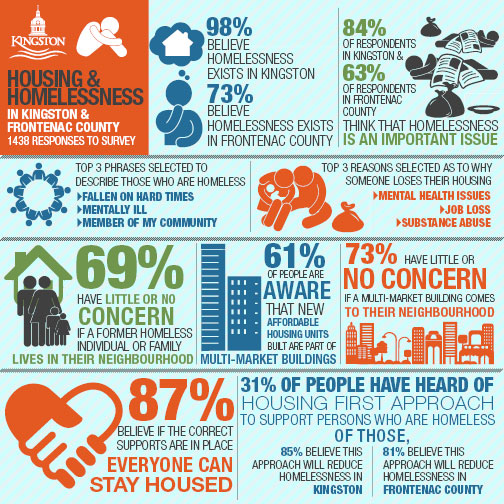The below infographic, published by the City of Kingston in Ontario, draws figures from a survey on housing and homelessness in Kingston and Frontenac County. It has been estimated that 400 individuals are homeless in Kingston and Frontenac County. The infographic looks at perceptions that survey respondents have about individuals living in homelessness, as well as awareness of measures being taken to address homelessness.
98% of survey respondents believe that homelessness exists in Kingston, while only 73% believe that homelessness exists in Frontenac County. We know homelessness exists in both areas, so why the discrepancy?
Potential Explanation: Presence of Hidden Homelessness in Frontenac County
A homelessness survey conducted in Frontenac indicated that the majority of homeless persons in the county, 83%, are hidden homeless. The term hidden homeless refer to people who live “temporarily with others but without guarantee of continued residency or immediate prospects for accessing permanent housing”. Such housing arrangements are not sustainable, long-term living arrangements, and individuals who are considered part of the hidden homeless do not have the ability to secure permanent housing in the near future. This subpopulation is less likely to be seen out on the streets. The presence of hidden homelessness is a possible contributing factor to why many survey respondents were unaware about the presence of homelessness in their county.
Since the hidden homeless do not usually access supports and services for the homeless, they may be overlooked and underserved. For example, they may be overlooked in point-in-time counts. Widely considered one of the best methods of counting homeless populations, point-in-time counts are a measure of the number of homeless people in an area on a specific day, essentially “taking a snapshot” of the situation. This method is far from effective for keeping track of the hidden homeless.
We can look at the literature to see what measures are being taken to learn more about the prevalence of hidden homelessness. A recent study conducted in Vancouver used a monthly telephone survey with multi-level random selection methods to estimate the number of hidden homeless in the city. The study found that there were 3.5 hidden homeless people for every homeless person.
Valuing Community Awareness
The survey found that 84% of respondents in Kingston think that homelessness is an important issue. While in Frontenac County, only 63% of respondents felt the same way. That’s a 21% difference.
If citizens of Frontenac County are unaware of the presence of homelessness in their area, it’s understandable that they are less likely to see homelessness as an important issue. Awareness of the presence of homelessness, especially hidden homelessness, plays a critical role in determining if community members think that homelessness is important. When we look at municipal responses to homelessness across the country that have been effective, the push for change often begins at the community level, with everyday citizens and even local businesses recognizing the need for a change to the status quo.
Beyond creating awareness of the presence of homelessness, it’s also important to consider the role that awareness can play in (1) dispelling myths about homelessness and (2) informing the general public about sustainable, long-term, solutions to homelessness.


